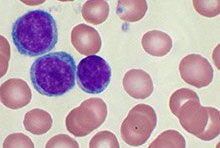
December 14, 2021
 Vashi Donsk/via Wikipedia
Vashi Donsk/via Wikipedia
High-power magnification of a Wright's stained peripheral blood smear showing chronic lymphocytic leukemia. The cancer cells are the lighter color.
Patients with higher risk chronic lymphocytic leukemia can stay in remission longer with a combined treatment of the drug ibrutinib and standard care, according to new research.
The study involved 85 leukemia patients who were all 65 or younger. Forty-six of them had higher risk chronic lymphocytic leukemia, which is a more aggressive and unmutated subtype of the cancer which starts in the blood and bone marrow.
Patients with a lower-risk but more heavily mutated subtype can successfully achieve long remission from a six-month regimen of chemotherapy drugs fludarabine and cyclophosphamide, along with the antibody therapy rituximab, Dr. Matthew Davids of Dana-Farber Cancer Institute explains.
Unfortunately, patients with higher risk chronic lymphocytic leukemia don't get the same lasting benefits from this treatment regimen. However, they do respond well to the drug ibrutinib, which blocks an enzyme the cancer cells need to survive.
The concern with the ibrutinib strategy though is that the cancer patients have to take the drug – which is associated with risks and side effects such as bleeding, upper respiratory infection and cardiac complications – for the rest of their lives in order to retain the benefits.
But in their study, Davids and his colleagues found that a shorter duration of the therapy, in combination with chemotherapy and rituximab, could also provide long remission in these patients.
At a follow-up of more than 40 months, 97% of the patients given the new treatment regimen were still alive with no worsening of their disease. An earlier follow-up of 16.5 months showed similar results.
And the small percentage of patients whose leukemia recurred after the 2.5-year mark did well when they started taking ibrutinib again.
"We're very encouraged about the potential of this therapy to generate long-term remissions in a broad population of younger patients with chronic lymphocytic leukemia," Davids said. "For young patients, in particular, who, hopefully, have decades of life ahead of them, the prospect of a time-limited therapy that can have such durable impact without the need for ongoing treatment is very impactful."
The American Cancer Society estimates that by the end of 2021, there will be about 61,090 new cases of leukemia, and 21,250 of those cases will be chronic lymphocytic leukemia. It accounts for about one-quarter of all new cases.
In the study, participants were given ibrutinib for seven days followed by a combination of ibrutinib and the chemotherapy-rituximab combo for up to six months. They then continued to take just ibrutinib alone for two more years. After the two year mark, those participants who had no detectable leukemia cells in their bone marrow could stop taking the drugs.
The findings were presented at the annual meeting of the American Society of Hematology. The findings are considered preliminary until published in a peer-reviewed medical journal.